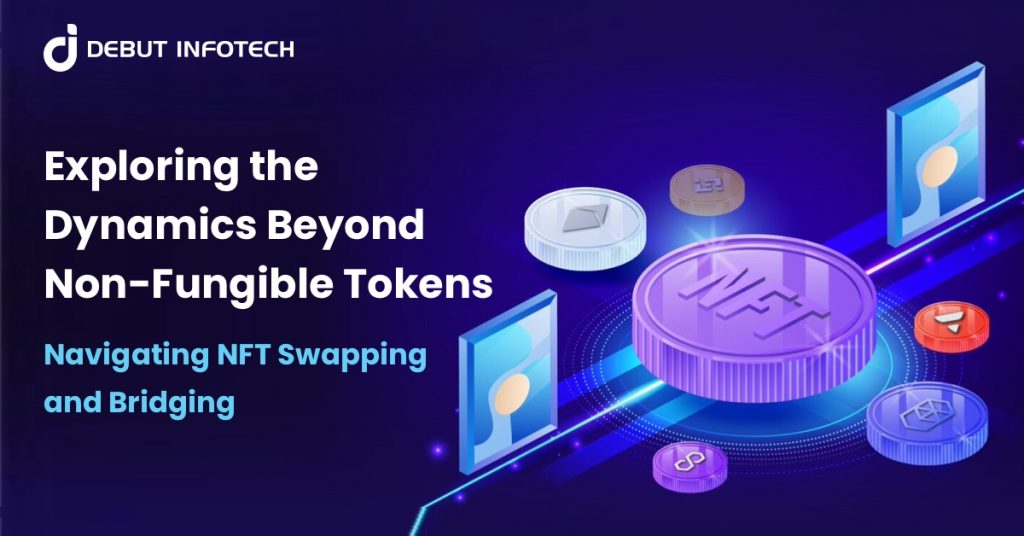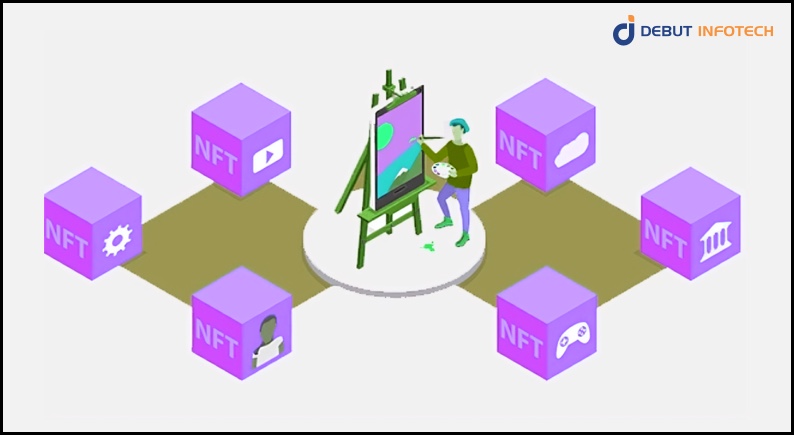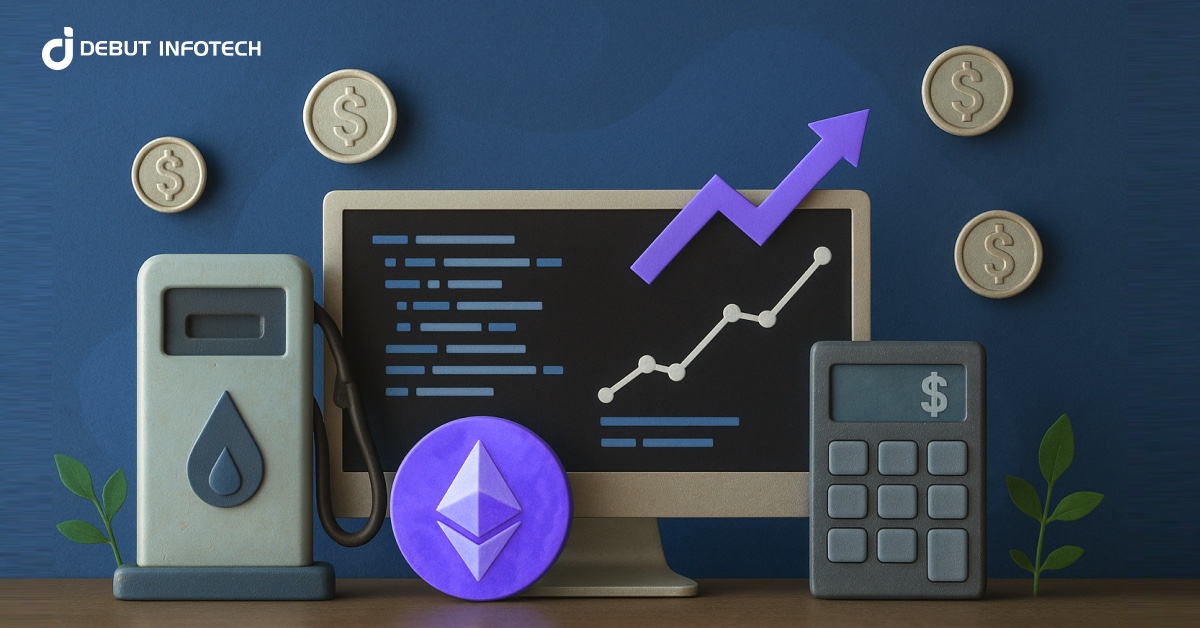
Asset trading has transformed since the introduction of Non-Fungible Token, a cutting-edge digital asset. Before NFT was introduced, users couldn’t tokenize and become the owners of digital assets. With the introduction of NFTs, digital artists and content producers can more effectively commercialize their creations and connect with secondary NFT markets that bring in money through loyalty rewards.
In parallel, NFT swapping and NFT bridging are experiencing an exponential increase, generating income for NFT collectors, gamers, cryptocurrency investors, and other stakeholders. In April 2022, the market capitalization of the top 5 NFTs listed on CoinGecko exceeded 10 billion USD, indicating the growing popularity of NFTs.
NFT And The Blockchain
The NFT marketplace and non-fungible tokens are powered by the noteworthy technology known as blockchain. Although there are increasing networks enabling NFTs, cross-chain trading between networks is challenging because most of these networks are separate from one another. Nevertheless, NFT trading in cross-platform networks can significantly increase the range of NFT profitability. Today, we will talk about NFT bridging and swapping, two methods that enhance the experience of trading NFT. NFT bridging enables NFT trading on a cross-platform network, whereas NFT swap allows a trader to get a higher price for his token. In this Insight, we will go further into NFT switching, including its functioning and impact on another industry.
What is NFT Swapping?
NFT swapping is the exchange of one non-fungible token (NFT) for another NFT or other digital assets, like cryptocurrencies. Over time, NFTs tend to lose value, and NFT history indicates that only a tiny fraction of NFTs maintain their relevance. NFTs lose value quickly, making it impossible for sellers to exchange. A user of the NFT swap platform can effortlessly purchase and sell an item at a premium price through NFT swapping. More individuals consider choosing the NFT swap to earn as fresh NFT collections enter the NFT swapping platform every day. The best way to profit from NFT swapping is to get an NFT from a new collection that has the potential to become highly sought-after by NFT collectors.
Predicting the success of a new collection is never simple. Still, the NFT industry is expanding, and many investors have made good money by buying early and reselling the NFT for a premium. The ultimate objective of this procedure is to purchase an NFT at a discounted floor price and resell it at a higher price when the NFT token’s value increases.
How Do You Swap NFTs?

There is now a sizable market for NFTs thanks to the development of multiple NFT trading ecosystems. NFTs’ cross-chain interoperability remains essential to their continued growth and development. Users on the NFT swap platform can purchase, sell, or trade directly with another user through NFT swapping.
Through NFT swap, you can exchange the following:
- NFTs for NFTs
- NFTs for Crypto
- NFT(s) for “NFT(s) + Crypto”
The NFT assets advertised for purchase, trade, swap, and other uses can be browsed by users in a library. The sellers of NFT assets prearrange the transactions in which buyers participate. NFT swapping is a service offered by most marketplaces. Let’s examine the procedures for how to swap NFT in an NFT market:
- Step 1: To begin swapping, you will have access to two libraries: the NFTs you wish to trade with and the library of NFTs you now own.
- Step 2: Select whether to swap a token or an NFT first.
- Step 3: Select the specific NFT you wish to exchange from the library if you decide to go with NFT.
- Step 4: Select the NFTs or tokens you would like to receive in return for your NFT from the other library.
- Step 5: swapping can begin as soon as your listing is prepared.
- Step 6: Finish the NFT Swap.
Types Of NFT Swapping
Different forms of NFT Swapping exist:
- Direct Swap: Direct swaps, the most common type of NFT swapping, entail trading one NFT for another of equivalent value. An automated market maker on a DEX determines the exchange rate between the two NFTs, enabling direct swaps. NFTs of comparable or equal value can be exchanged using direct swaps, which are simple to comprehend.
- Multi-Asset Swaps: A multi-asset swap involves trading one or more NFTs for numerous NFTs. Collectors looking to consolidate their collections or sell a collection of NFTs for a single, more costly NFT might find this helpful. Multi-asset swaps may be carried out via DEXs, which allow for the simultaneous swapping of several assets.
- Auction-based Swaps: Several DEXs allow for the swapping of NFTs via auctions, where buyers and sellers can bid on NFTs until a specific price is met. This can be a helpful way to get rare or highly sought-after NFTs. Auction-based swaps can be carried out on DEXs with built-in auction systems or external auction platforms.
- Fractional Swaps: An NFT can be owned in fractions through fractional swaps, where each user has a portion of the NFT. Those who wish to invest in a lucrative NFT but cannot pay cash for it may find this helpful. Fractional swaps can be performed via fractionalization platforms or DEXs that support fractional ownership.
- Wrapped NFT Swaps: In some situations, wrapped NFTs from one blockchain network can be swapped for wrapped NFTs from another. This could be useful for collectors who want to purchase NFTs that aren’t available on the blockchain network of their choice. Wrapped NFT swaps can be executed using specialized DEXs or wrapped NFT marketplaces.
What Is NFT Bridging?

The job of an NFT bridge is to establish a connection between two distinct networks and permit the exchange of NFT tokens or data between them. Although each network has its protocols, the bridge offers a workable way for both sides to connect safely. An NFT blockchain-powered connects two distinct places like a real-world bridge would. It makes it possible for resources to move across ecosystems. A cross-chain NFT bridge is a collection of well-written code and smart contracts that allow users of the NFT marketplace to move tokens, events or instructions from smart contracts or even data between blockchains.
NFTs are subject to the idea of bridging between networks, which offers an NFT marketplace user the following benefits:
- The capability of transferring NFTs to the preferred blockchain networks.
- Utilizing the cross-chain portal to make the NFTs available on all markets.
- Enabling sales and auctions across chains.
- The price value will remain constant with NFTs even if the network changes.
- Offer your NFTs on all the platforms with well-known blockchain networks.
How Does Bridging NFTs Work?
For an NFT to become locked, a user must deposit it into a Network ‘A’ Smart Contract. The user must then obtain the oracle’s signatures to verify that he deposited in network ‘A’. The user can call the same smart contract in network ‘B’ with the signatures, and a duplicate NFT is created and sent to the user. Assume that the user requests the return of the original on network ‘A’. In such a scenario, the user must invoke the contract in network ‘A’, where the original will be freed, send the duplicate NFT to the bridge to be burnt, and request signatures from the oracle once more to verify that it occurred.
Types Of NFT Bridges
- Token wrapping: This is moving a non-fungible token (NFT) from one blockchain network to another by wrapping it in an appropriate format. The wrapped token could be traded for the original NFT in the original network.
- NFT Cross chain bridge: Two distinct blockchain networks must be connected by a bridge to transfer NFTs. For this, specialized protocols and smart contracts can be employed.
- Sidechain bridging: During sidechain bridging, NFTs are moved from one sidechain to the main blockchain network. Sidechains are separate blockchain networks linked to the main network and have specific uses.
- Atomic swaps: These entail the simultaneous, direct transfer of NFTs between several blockchain networks. This can be accomplished through smart contracts and specially designed protocols.
Debut Infotech is a blockchain development firm that provides services and solutions for NFT bridging and marketplace development. They also offer services for smart contract creation, wallet construction, node building, blockchain consultancy, maintenance, and upgrades by using services like NFT Swap SDK. The NFT Swap SDK is the simplest and most potent swap library on the EVM, and it supports chains compatible with Ethereum and the EVM, such as Polygon, Avalanche, and BSC.
This feature will allow a user to bridge an NFT to Polygon development. NFT Swap SDK functions with Node.js and browsers alike and is created with the 0x protocol and written in TypeScript. You can use this library to create support for peer-to-peer, over-the-counter (OTC), and NFT marketplaces.
Conclusion
Businesses and startups aim to create web3-based NFT marketplaces that can leverage the reliable and open-source exchange infrastructure of bridging and swapping to drastically cut down on the work needed to provide their NFT marketplace users with a smooth multi-chain experience. The NFT marketplace facilitates the exchange of non-fungible cross-chain network tokens through smart contract technology. NFT swapping and NFT bridging address the interoperability issue in NFT trading across several blockchains. The NFT business is growing rapidly, and as more blockchain networks prioritize interoperability, NFT trading will occur on larger platforms. NFT swapping and bridging are two viable trading strategies to further the interests of NFT developers and traders.
Frequently Asked Questions
Q. What is involved in NFT Swapping?
A. NFT swapping is the act of immediately trading one non-fungible token (NFT) for another without the use of a middleman. This enables NFT holders to add desired assets to their portfolios or diversify their holdings.
Q. How is NFT Swapping carried out?
A. Decentralized exchanges (DEXs) or other specialized platforms that facilitate the direct exchange of NFTs are commonly used in NFT swapping. Users choose which NFTs to swap, connect their digital wallets to these platforms, and then execute the trade with other users or liquidity pools.
Q. What advantages can NFT swapping offer?
A. Increased liquidity for NFT holders, the freedom to trade without depending on centralized exchanges, and the chance to access a greater variety of assets without requiring further fiat currency conversions are just a few benefits of NFT exchanging.
Q. How does NFT Bridging work?
A. Moving NFTs between other blockchain networks is known as NFT bridging. Usually, this is done to facilitate cross-chain functionality and get around interoperability restrictions so that NFTs can be used in many ecosystems.
Q. How does NFT Bridging facilitate interoperability?
A. NFT bridging uses specific technologies and protocols to facilitate the smooth movement of NFTs between compatible blockchain networks. Users can contact Debut Infotech to get help in the right places.


